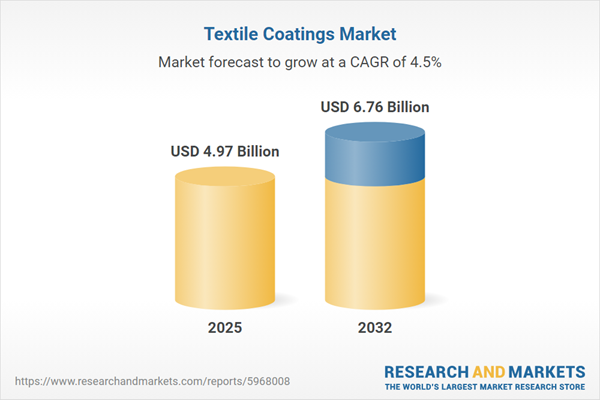Speak directly to the analyst to clarify any post sales queries you may have.
The textile coatings market is adapting rapidly as sustainability, compliance, and supply chain considerations reshape decision-making at the highest levels. Industry leaders need insight-driven intelligence to guide strategic responses, optimize sourcing, and strengthen organizational resilience.
Market Snapshot: Textile Coatings Market Growth and Trends
The global textile coatings market is projected to rise from USD 4.75 billion in 2024 to USD 4.97 billion in 2025, reflecting a 4.50% CAGR. This steady trajectory results from ongoing demand across applications in automotive, healthcare, and industrial manufacturing. Organizations increasingly invest in adaptive supply chains and prioritize procurement frameworks that ensure regulatory alignment and operational transparency. Executives are adjusting to rapidly shifting regulatory and geopolitical environments by embedding compliance technology and promoting robust process flexibility. These tactics keep businesses competitive, ensuring both continuity and proactive risk management in a complex, evolving market landscape.
Scope & Segmentation: Textile Coatings Market
- Coating Material: Specialized coatings, including acrylic, polyolefin, polyurethane, PVC, and silicone, serve diverse performance needs, from enhanced durability to improved technical function, making them vital for automotive, healthcare, and packaging sectors.
- Coating Technology: Main categories—100% solids, hot melt, solvent-based, and water-based—are evaluated based on sustainability compatibility, regulatory trends, and resource efficiency, with growing attention to technologies reducing environmental impact.
- End Use: Textile coatings are key in automotive interiors, technical footwear, upholstered furniture, medical applications, fire protection, industrial safety gear, military sectors, marine fabrics, and flexible packaging, supporting specialized and high-reliability products.
- Textile Type: Substrates such as knitted, woven, and nonwoven textiles influence product reliability and adaptability, meeting detailed requirements across industry-specific applications.
- Geographic Regions: Market demand and supply chain trends differ across the Americas, Europe, Middle East, Africa, and Asia-Pacific, with attention on shifts in consumer expectation, compliance standards, and sourcing practices at the regional level.
- Key Companies: Market benchmarks include leading firms such as PPG Industries, Akzo Nobel, BASF, Dow, Huntsman, Covestro, Archroma, Hempel, Jotun, and Eastman Chemical, aiding thorough competitive evaluation and strategic planning.
Key Takeaways for Senior Decision-Makers
- Adopting water-based and low-emission coatings aligns offerings with regulatory and sustainability expectations, supporting market access and brand reputation in competitive regions.
- Building productive partnerships with suppliers and manufacturers drives compliance readiness and streamlines integration with evolving client requirements across established and emerging geographies.
- Deploying digital production platforms and integrating advanced coatings, such as antimicrobial and conductive variants, positions organizations to address technical priorities in healthcare and specialized textile applications.
- Maintaining a wide supplier network underpins operational adaptability, especially in dynamic trade environments or amid regional disruptions, while strengthening long-term business continuity.
- Investing in advanced quality assurance and pioneering material innovations boosts reliability and compliance, which is essential for sustained positioning in international supply chains.
Tariff Impact: Navigating New Trade Realities
Shifts in U.S. tariff strategy are prompting reevaluation of procurement and sourcing decisions within the textile coatings sector. Companies increasingly look to domestic and regional manufacturing solutions to counter volatility in international trade rules. Enhanced supplier engagement and streamlined purchasing structures help organizations retain agility, reduce market risk exposure, and meet evolving compliance obligations amidst global regulatory shifts.
Methodology & Data Sources
This market research report uses extensive secondary research and incorporates expert input from industry professionals, producers, and end users. Subject matter authorities have cross-validated all insights, ensuring senior executives receive credible, actionable support for strategic planning in the textile coatings market.
Why This Report Matters for Textile Coatings Stakeholders
- Supports executives in shaping sustainable, compliance-driven business strategies to meet global market requirements.
- Clarifies actionable risks and highlights emerging growth opportunities with segment-specific best practices and dynamic supply chain insights.
- Provides segmentation tools and benchmarking perspectives that enable rapid, informed strategic decisions and continual competitive assessment.
Conclusion
This analysis equips industry leaders to refine strategic focus, enhance supply chain strength, and identify opportunities as the textile coatings market continues to evolve.
Additional Product Information:
- Purchase of this report includes 1 year online access with quarterly updates.
- This report can be updated on request. Please contact our Customer Experience team using the Ask a Question widget on our website.
Table of Contents
3. Executive Summary
4. Market Overview
7. Cumulative Impact of Artificial Intelligence 2025
Companies Mentioned
The companies profiled in this Textile Coatings market report include:- PPG Industries, Inc.
- Akzo Nobel N.V.
- BASF SE
- Dow Inc.
- Huntsman Corporation
- Covestro AG
- Archroma Management, LLC
- Hempel A/S
- Jotun A/S
- Eastman Chemical Company
Table Information
| Report Attribute | Details |
|---|---|
| No. of Pages | 189 |
| Published | October 2025 |
| Forecast Period | 2025 - 2032 |
| Estimated Market Value ( USD | $ 4.97 Billion |
| Forecasted Market Value ( USD | $ 6.76 Billion |
| Compound Annual Growth Rate | 4.5% |
| Regions Covered | Global |
| No. of Companies Mentioned | 11 |









